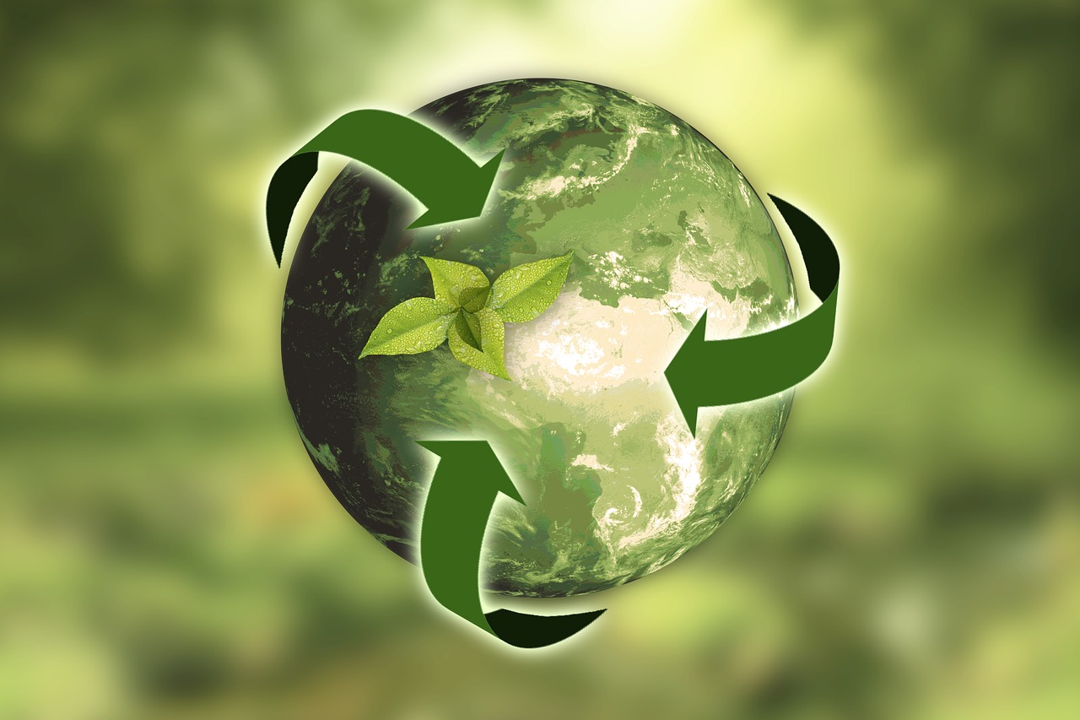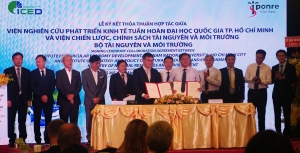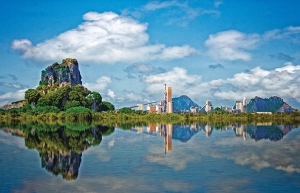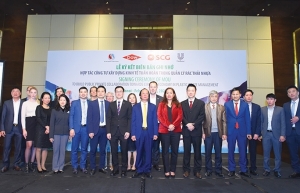Circular economy central to COVID-19 recovery and long-term growth across ASEAN
 |
| The EU-ABC Chas made a strong case for a shift towards the circular economy |
Donald Kanak, chairman of the EU-ABC and Eastspring Investments, said, “Circular economy models provide the foundation for resilience, preparedness, and competitiveness, bringing crucial benefits for both the economy and the environment across all levels. This will be vital in addressing the environmental complications stemming from climate change and the increasing amounts of waste produced by the ASEAN’s fast-expanding economies and populations.”
“This approach is aligned with regional objectives discussed at the recently concluded 36th ASEAN Summit, where leaders reiterated the need for a comprehensive recovery framework that is robust, holistic, inclusive, gender-responsive, and science-based, safeguarding the region’s long-term prosperity,” he added.
In line with the regional vision for a cohesive and responsive ASEAN, the EU-ABC positions circularity as a catalyst for sustainable growth, providing recommendations that not only mitigate the socioeconomic damage caused by COVID-19 but also drive long-term growth.
Linear economy models based on the assumption of limitless resources and waste absorption capacity have created a legacy of vulnerability and displacement that is unsustainable. Circular economy models are designed to decouple economic growth from resource consumption, enabling businesses, society, and the environment to thrive symbiotically. It is based upon three principals – reducing waste and pollution, maximising the potential of products and materials, and allowing natural ecosystems to regenerate by avoiding the use of non-renewable resources.
While the circular economy approach touches on all aspects and streams of waste, the EU-ABC’s paper highlights the urgency of addressing plastic wastage. According to the United Nations, cities in Southeast Asia are responsible for as much as 60 per cent of plastic waste globally, with plastic making up 18 per cent of the ASEAN’s municipal waste. The issue is exacerbated by the unregulated dumping and burning of waste, along with the limited infrastructure to support the proper disposal of plastic waste.
Left unchecked, these practices not only aggravate climate change but also incur significant costs for the ASEAN. Putting things in perspective, the World Economic Forum estimates plastic packaging waste to cost the global economy $80-120 billion each year, while the United Nations Environment Programme (UNEP) has found plastic litter to cost the Asia-Pacific’s tourism, fishing, and shipping industries $1.3 billion per annum.
Leslie Chong, public affairs and communications director, Asia, Middle East, and Africa at FrieslandCampina, said: “Circularity is key to operating in balance with nature. FrieslandCampina’s purpose," Nourishing by Nature", is about sustainable nutrition and making the entire dairy chain more sustainable, from grass to glass. Climate-neutral products can only be achieved if governments, consumers, retailers, other companies, and suppliers all contribute to this movement. We stand ready to work with public and like-minded stakeholders to make progress towards building inclusive local green economies.”
Hermann Althoff, senior vice president at BASF’s Performance Chemicals unit in the Asia-Pacific, said, “At BASF we are committed to creating a sustainable future and are developing a broad range of products to enable the shift from a linear to a circular economy. Our plastic additives are one way that customers can reduce greenhouse emissions, use resources more efficiently, and reduce plastic waste. Keeping plastics out of landfills helps extend the loop for this valuable material on our way to a circular economy.”
The EU-ABC’s position paper comes at a good time as ASEAN member states begin to discuss and implement various COVID-19 recovery strategies, creating a window of opportunity to recalibrate economies for sustainable growth. ASEAN leaders will once again be meeting via video conference on July 30 to discuss pandemic and post-pandemic recovery plans for the region. Green growth now, more than ever, needs to be featured more prominently, being vital to secure the ASEAN’s long-term economic competitiveness and resilience. Although sustainable growth has been a priority for ASEAN leaders, more can still be done to move the needle.
Taking a circular approach can lower costs of production, increase trade and investment with like-minded trading partners such as the European Union and South Korea, and drive the creation of jobs, creating a healthy ecosystem that allows future generations in the ASEAN to thrive. The Economic Research Institute for ASEAN and East Asia (ERIA) also found that the adoption of circular economy models in Asia could bring about economic growth of $324 billion and create 1.5 million jobs by 2025. Combined with the cost savings from implementing a circular approach, this could potentially reverse the impact of COVID-19 in a quick and sustainable manner.
The paper notes that as the effects of climate change and environmental degradation harm those at the bottom of the socioeconomic ladder the most, adopting the circular economy does not just contribute to the fight against climate change, or bring in additional revenues – it also secures a better future for the people of the ASEAN. Government-led national directives will thus play a crucial role to kickstart, direct, and sustain the process of convincing commercial organisations about the benefits of circular economies.
| Recommendations from the EU-ABC 1. Short-term approach for national governments At the earliest opportunity, governments should put in place processes necessary to support a circular economy for plastics, some of which include waste collection, separation, and reuse. Costs should also be imposed on negative externalities to discourage the commercial use of plastic. Public-private consultations will be a vital enabler, and would allow to discuss plans for longer-term sustained initiatives. 2. Medium- to- long- term approach for national governments For medium- to long-term gains, governments should invest in supporting organisations in their transition to circular economy models, starting with education and training before moving on to innovation incubators. Proper regulations and framework should also be implemented for the waste collection industry, with appropriate training provided to workers in the sector. Finally, the standardisation of recycling labels will help ensure regional rather than piecemeal efforts. 3. On an ASEAN level To further drive regional momentum, the ASEAN Secretariat could spearhead research and innovation efforts into sustainable polymers and packaging that could be used as an alternative to plastic. An ASEAN wide framework agreement on plastic pollution could also be negotiated to create a common regional approach that would reaffirm the commitment and ability of member states to jointly address challenges.
|
|
|
 First Institute of Circular Economy Development established in Vietnam First Institute of Circular Economy Development established in Vietnam |
 Manufacturers taking the lead in the circular economy Manufacturers taking the lead in the circular economy |
 Unilever leading the charge to build a circular economy across Vietnam Unilever leading the charge to build a circular economy across Vietnam |
What the stars mean:
★ Poor ★ ★ Promising ★★★ Good ★★★★ Very good ★★★★★ Exceptional
Themes: Drive ASEAN Forward
Related Contents
Latest News
More News
- Heavy industries set for pilot greenhouse gas quotas (December 25, 2025 | 10:00)
- Swedfund invests in MSME growth and climate action in Vietnam (December 19, 2025 | 11:42)
- GreenYellow brings solar energy to light up remote schools in Tuyen Quang province (December 19, 2025 | 08:00)
- Charge+, Grab partner to develop EV charging network in Vietnam (December 18, 2025 | 17:11)
- Linking sci-tech and innovation to Vietnam’s net-zero future (December 18, 2025 | 14:31)
- Driving double-digit growth through green and circular transformation in Vietnam (December 17, 2025 | 09:00)
- Standard Chartered and ACCA deepen collaboration to develop Vietnam’s talent for a sustainable future (December 15, 2025 | 18:18)
- Schaeffler reports strong early output from Dong Nai solar project (December 12, 2025 | 15:16)
- Forestry conference highlights biodiversity and sustainability goals (December 09, 2025 | 13:35)
- Home Credit honoured among top 10 sustainable companies in trade and services (December 09, 2025 | 12:18)

 Tag:
Tag:
























 Mobile Version
Mobile Version